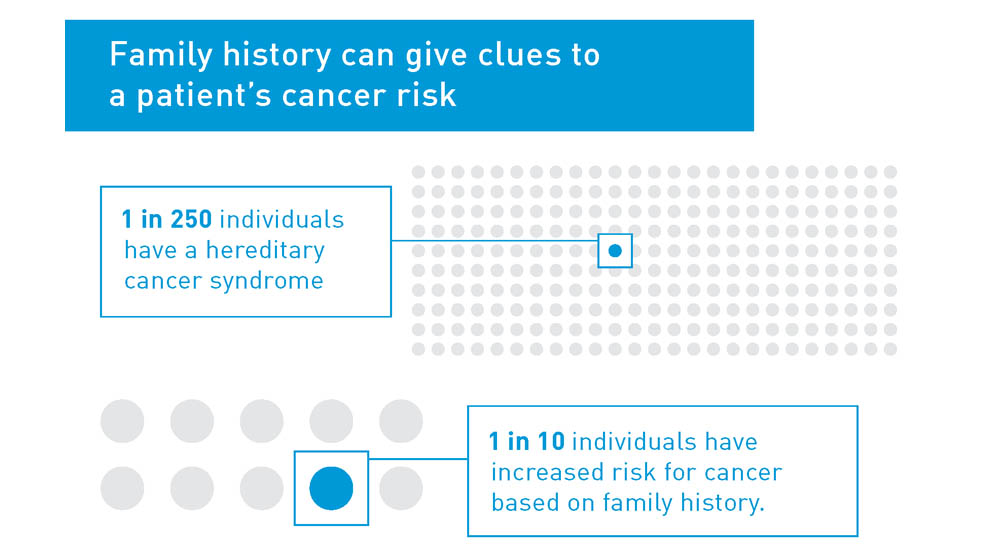
As 1 in 10 people are at increased risk for cancer, but often go undetected, knowing who these people are can lead to personalized management and better health outcomes. In order to identify such individuals, family history information is often key. We’ll guide you through the steps of gathering a useful family history so that you can efficiently and effectively assess risk.
Here’s what you can do now: 3 steps to collecting a quality family history
Start by telling your patients why family history is valuable in assessing their cancer risk. The process of eliciting a family history also provides an excellent opportunity to build a relationship with the patient and to become aware of the patient’s motivations and concerns.
1. Ask about the right family members
- At least first (parents, children, siblings) and second (grandparents, aunts/uncles, grandchildren) degree relatives.
- Both sides of the family
2. Ask about the family structure
- Family relationships (e.g., half-siblings, intermarriages)
- Unaffected relatives
3. Ask about health milestones
- Details about diagnosis and the extent of disease, including
- Was a “female cancer” ovarian, uterine, cervical?
- Was the prostate cancer metastatic?
- Was more than one cancer found in a relative?
- Ages of disease onset
- Age at death, whether or not it was related to disease
If your patient doesn’t know the answers to these questions, ask them to gather additional information, if possible. When family history information is limited, it may still be possible to assess for risk based on personal history and/or consulting with a genetic expert.
Family history, when collected in sufficient detail, can provide important information about your patients’ level of cancer risk. Understanding their risk can help you determine if a referral to genetic services is indicated. Ultimately, identification of individuals at increased or high risk will provide guidance on developing an appropriate management plan.
Make a commitment: Establish a system for family history collection at the practice level
To improve identification of individuals at increased risk of cancer, clinicians need to recognize those patients who have a personal and family history that increases their cancer risk and identify the appropriate cancer screening and genetic services indicated for a given patient. The most successful programs are those that engage the entire practice in developing and implementing a systematic, team-based approach to family history collection and interpretation. Generally, a family history process identifies when to collect and where to document family history data, the team members who are involved in collection and interpretation, and any tools used to aid the patient or provider in collecting or assessing family history.
Here are some features that have been helpful for practices setting up a family history system:
- Have the patient collect family history information before the provider visit, and/or identify another team member such as a nurse or medical assistant who can help collect this information. Collecting this information prior to the visit allows the patients to research their family history more completely and provide more accurate information.
- Identify time for a team member to review the patient’s provided family history and clarify any information, as needed.
- Provide patient education before and/or during family history collection, at the appropriate literacy level and in the patient’s preferred language, to help the patient understand why it is important to share family health history with the provider and how to learn more about the family history.
- Use a tool to aid in standardized family history collection and/or risk assessment.
- Document family history in the medical record consistently across the practice.
You can use this curated list of family history collection tips and tools so you’ll have easy-to-access resources and downloadable tools whenever you’re ready to improve your practice’s family history process.
Get your patients involved in the process
Alerting your patients to the type of information that is most useful to gather when speaking with relatives will increase efficiency in your family history documentation, and will help you stratify patients into level of risk more accurately. Encourage your patients to take advantage of the holiday season to gather family history.
Does your practice have a social media presence? The NIH Toolkit has messages already prepared for you to share with your patients online. Old school? Print out and post the graphics provided.